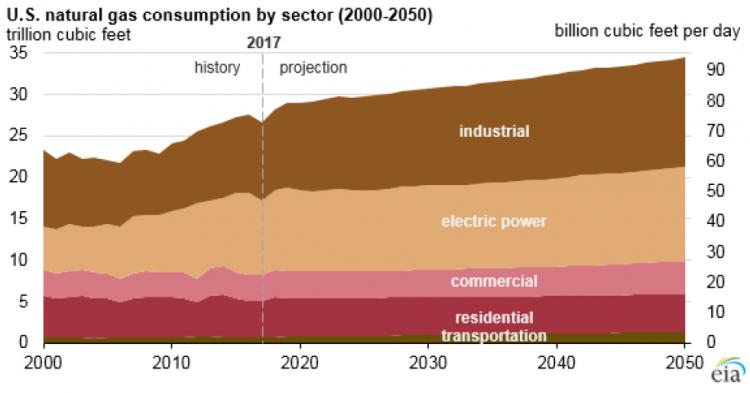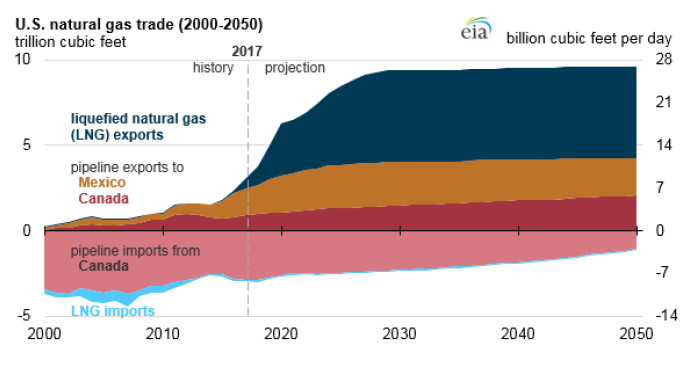Shale Energy Utilization
Shale energy production includes natural gas, natural gas liquids, and oil; therefore, a variety of hydrocarbons may be produced from a single well. This module considers the utilization of each of these types of hydrocarbons. As you recall, the Marcellus shale produces primarily dry gas but does produce significant volumes of natural gas liquids and even some oil in portions of southwestern and western Pennsylvania. The graphic below shows that in 2017 Pennsylvania produced approximately 5.36 TCF of gas, but used just over 1 TCF of gas, therefore over 4 TCF was exported to other states.

Natural gas is a very versatile fuel with important uses in residential and commercial heating, industrial use, power generation, feedstock for the petrochemical industry, and fertilizer production. As a whole, the United States used about 27.11 TCF of natural gas in 2017, consisting of 29% of total U.S. energy consumption. Natural gas use by U.S. consuming sectors by amount and share of total U.S. natural gas consumption in 2017 is shown in the graph projected out to 2050 and summarized by percent use below.

According to the EIA, the following natural gas utilization trends occurred in 2017:
- The electric power sector accounted for about 36% of U.S. natural gas consumption, and natural gas was the source of about 27% of the U.S. electric power sector's energy consumption. This video by Dr. Seth Blumsack describes the influence of shale gas on the power grid.
Seth Blumsack: Shale Gas influence in Power Grid (1:46)
David Yoxtheimer: How has shale gas impacted the power grid?
Seth Blumsack: Electric power is really the fastest growing source of demand for natural gas. And over the past several years, natural gas has been really rapidly supplanting coal for power generation, so the amount of coal we use for power generation has gone way down, and the amount of natural gas we use for power generation has gone way up. Natural gas is also just starting to supplant nuclear power. And so, what's going on here is basic economics. Natural gas has gotten so cheap that there are lower costs to generate electricity with natural gas than for coal and increasingly lower costs to generate electricity with natural gas than nuclear. How natural gas competes with renewables is a different story and one that's changing really rapidly. So, we tend to make these cost comparisons using a number called the levelized cost, which is basically like an average cost to produce electricity from some fuel source. And so if you look at the levelized cost for gas versus the levelized cost for wind or solar, you'll see that right now, renewables are several times more expensive than natural gas to produce electricity. But the costs for wind and solar are coming down so fast that within five or ten years, it may well be the case that renewables are cost-competitive with natural gas for generating electricity.
- The industrial sector uses natural gas as a fuel for process heating and for combined heat and power systems and as a raw material (feedstock) to produce chemicals, fertilizer, and hydrogen. In 2017, the industrial sector accounted for about 34% of U.S. natural gas consumption, and natural gas was the source of about 31% of the U.S. industrial sector's energy consumption.
- The residential sector uses natural gas to heat buildings and water, to cook, and to dry clothes. About half of the homes in the United States use natural gas for these purposes. In 2017, the residential sector accounted for about 16% of U.S. natural gas consumption, and natural gas was the source of about 22% of the U.S. residential sector's energy consumption.
- The commercial sector uses natural gas to heat buildings and water, to operate refrigeration and cooling equipment, to cook, to dry clothes, and to provide outdoor lighting. Some consumers in the commercial sector also use natural gas as a fuel in combined heat and power systems. In 2017, the commercial sector accounted for about 11% of U.S. natural gas consumption, and natural gas was the source of about 18% of the U.S. commercial sector's energy consumption.
- The transportation sector uses natural gas as a fuel to operate compressors that move natural gas through pipelines. A relatively small amount of natural gas is used as vehicle fuel in the form of compressed natural gas and liquefied natural gas. Nearly all vehicles that use natural gas as a fuel are in government and private vehicle fleets. In 2016, the transportation sector accounted for about 3% of total U.S. natural gas consumption. Natural gas was the source of about 3% of the U.S. transportation sector's energy consumption in 2017, of which 97% was for natural gas pipeline and distribution operations.
It is worth noting that imports and exports of gas via pipeline from and to Canada and Mexico also occur, with an increasing share of natural gas being exported from the US as liquified natural gas (LNG) to the global market over the next decade as shown in the graphic below.

The EIA estimates that in 2017, about 4.67 million barrels per day of crude oil and natural gas liquids were produced directly from tight oil resources in the United States, equal to about 50% of total U.S. crude oil production in 2017. Nearly all of the crude oil that is produced or imported into the United States is refined into petroleum products such as gasoline, diesel fuel, heating oil, and jet fuel, which are then consumed at an average of about 19.96 million barrels per day with the following utilization breakdown:
- Gasoline use averaged about 9.33 million barrels per day, which was equal to about 47% of total U.S. petroleum consumption.
- Distillate fuel oil, including diesel fuel and heating oil consumption in 2017 averaged about 3.93 million b/d, which was equal to 20% of total U.S. petroleum consumption.
- Natural gas liquids such as ethane, propane, butane, pentane, and condensate are used for plastics production (ethane, propane), heating (propane), and as well as gasoline additives (butane, pentane, condensate). According to the EIA, natural gas liquids consumption in 2017 averaged about 2.64 million barrels per day with approximately 50% of this production coming out of the Appalachian Basin.
- Jet fuel is the fourth most-used petroleum product in the United States and about 1.68 million b/d in 2017.
- The remaining 2.38 million barrels per day of petroleum products used include asphalts, kerosene, petrochemical products, coke, and miscellaneous other products.
- Clearly, shale-derived sources of energy play a major part of the US energy portfolio and of our daily lives, which is especially remarkable given that these resources have only been developed in significant volumes over the last decade.